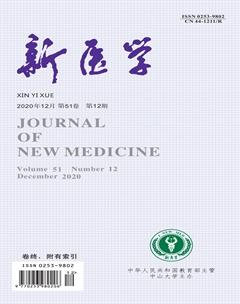3D打印技术辅助腹主动脉瘤腔内治疗一例
王湘?蔡震宇?于洪涛?李刚



【摘要】腹主动脉瘤是指与全身纤维结缔组织退行性变相关联的腹主动脉局部瘤样扩张,是常见的主动脉疾病。近年随着三维(3D)打印技术的不断进步,其在医疗领域应用的范围不断扩大,特别是在血管外科的运用。该文介绍1例腹主动脉瘤3D打印辅助治疗实例,与传统主动脉CT血管造影(CTA)检查进行对比,基于CTA图像的3D打印技术能够精准地还原CTA重建图像,测量数据更客观,使外科医师获得更直观的视觉理解,有助于手术的顺利进行。
【关键词】腹主动脉瘤;腔内治疗;三维打印
3D printing-assisted intraluminal treatment of abdominal aortic aneurysm: a case report Wang Xiang, Cai Zhenyu, Yu Hongtao, Li Gang. Cardiovascular Surgery, Shenzhen Hospital of Fuwai Hospital, Chinese Academy of Medical Sciences, Shenzhen 518000, China
【Abstract】Abdominal aortic aneurysm refers to the local tumor-like dilatation of the abdominal aorta associated with the degeneration of systemic fibrous connective tissues, which is a common type of aortic disease. In recent years, with the persistent advancement of three-dimensional (3D) printing technology, its range of application in the medical field has been constantly expanded, especially in vascular surgery. In this article, one case of 3D printing-assisted treatment of abdominal aortic aneurysm was reported. Compared with traditional aortic CT angiography (CTA), 3D printing technology based on CTA image can more accurately restore the reconstructed CTA image, yield more objective measurement data, deliver more intuitive visual understanding to the surgeons and contribute to the success of surgery.
【Key words】Abdominal aortic aneurysm;Intraluminal treatment;Three-dimensional printing
三維(3D)打印技术起源于一百多年前美国研究的照相雕刻和地貌成型技术[1]。它是一种以数字模型数据为基础,综合了数字运算、信息技术、材料学与化学等多方面技术,通过计算机控制,采用分层加工、叠加成型的方式来“制造”产品,故又称为“增材”制造技术[2]。1986年美国科学家Charles Hull开发了第一台商业3D打印机[3]。经历了30年的发展,3D打印技术的应用范围从航天航空、汽车制造、桥梁建筑逐渐延伸到了医学领域。在血管外科领域,主动脉瘤的治疗方案取决于腹主动脉瘤的解剖学形态,主动脉的扩张及扭曲程度、瘤颈长短、主要分支与瘤体间关系、瘤体内附壁血栓等因素将直接影响手术方案的选择以及患者预后的判断[4]。通过 3D 打印技术能够精准复制动脉瘤,可直视下全方位了解病变的解剖学情况。本文介绍1例腹主动脉瘤3D打印实际模型,并与传统主动脉CT血管造影(CTA)检查进行对比,初步探讨基于CTA图像的3D打印技术的相关应用价值及其准确性和可塑性。
病例资料
一、主诉及病史
患者男,68岁。因突发腰、背痛15 h余于2017年7月3日急诊入院。患者诉疼痛性质剧烈,为撕裂样疼痛,持续不缓解,伴全身乏力。既往有胆囊结石病史,已行手术治疗,否认高血压、糖尿病史,否认乙型肝炎、结核等传染病史,否认外伤及手术史,未发现食物及药物过敏史。吸烟约40年,20支/日。
二、体格检查及辅助检查
入院体格检查:体温36.6℃,心率82次/分,血压 110/68 mm Hg(左上肢,1 mm Hg = 0.133 kPa),呼吸20次/分。神志清晰,精神状态差,痛苦面容,口唇无发绀。双肺呼吸音清,各瓣膜听诊区未闻及明显病理性杂音。腹膨隆,无压痛及反跳痛,肠鸣音正常。双侧肢体波动减弱。
血常规示血红蛋白90 g/L,白细胞12.7 ×109/L,红细胞2.9×1012/L,血小板143×109/L。UCG示LVEF 0.55,心腔结构未见异常。全主动脉增强CT扫描提示腹主动脉瘤并腹主动脉破裂。术前CT血管三维重建显示患者肾下腹主动脉呈囊性扩张。瘤体最大直径约96 mm,瘤体真腔最大直径约45 mm,瘤体破口位于右侧肾动脉以下,瘤颈向右侧略偏斜,无明显扭曲,长度约15 mm,见图1。
三、3D模型重建及打印
提取患者术前主动脉(从腹腔干动脉上方到股动脉分叉处)薄层增强CT扫描资料,并以DICOM格式输出,将导出的主动脉CT扫描资料导入 Mimics 软件,对主动脉区域进行三维重构,重构后的数据输入 Cura软件进行切片设置,将转换后的.x3g格式文件拷贝到SD卡,然后利用武汉嘉一公司科易乐-巧匠E73D打印机进行打印,打印材料为聚乳酸生物可降解材料(PLA),分别打印成型腹主动脉瘤及腹主动脉瘤腔模型。该模型完整地展示了患者腹主动脉瘤及腹主动脉瘤腔的形态,见图2。
四、CTA重建图像及3D打印模型测量对比
腹主动脉瘤3D打印模型精准还原CTA重建图像:肠系膜上动脉、双侧肾动脉、双侧髂总动脉及分支、肾动脉与瘤颈关系、扭曲的瘤颈以及瘤颈长度、髂外动脉扭曲(具体测量数值见表 1)。肠系膜下动脉在CTA重建图像及3D打印模型中均无显现。
五、手术治疗
术中取右股动脉及左股动脉相应部位皮肤切口,造影见腹主动脉瘤巨大,直径约10 cm,长约14 cm,未累及左右髂动脉,形态特征基本与CTA及3D打印模型测量值相符。顺利置入美敦力ENBF2516C145EE腹主动脉主体覆膜支架1枚,分别经左、右侧股动脉顺利置入美敦力ENLW1610C120EE、ENLW1613C120EE短腿支架各1枚。最后造影示所释放支架位置均准确固定,腹主动脉瘤被完全隔绝,双侧肾动脉、双侧髂总动脉、双侧髂外动脉、髂内动脉显影好,无造影剂滞留,无造影剂外溢,无内漏,见图3A。术程顺利,术中无输血,术毕安返ICU,术后复查 CTA 结果满意,见图3B。随访至撰稿日,未见异常。
讨论
CTA技术采用图像后处理软件进行多平面重建(MPR)、最大密度投影(MIP)、容积成像(VR),综合影像结果进行诊断,可观察主动脉瘤发生部位、形态、大小和累及范围,并依据专为腹主动脉瘤腔内修复术制定的三型五分法及其测量指标进行测量及分型,对临床进行指导[5]。
在主动脉腔内治疗的术前指导过程以及主动脉相关形态学研究中,CTA技术未能完全满足需求,这主要与CTA本身局限的计算平台功能有关[6]。例如“梯形瘤颈”直径、动脉瘤最大直径、动脉瘤腔最大直径的测量,CTA存在一定的误差,这种误差与主动脉在矢状位的扭曲和倾斜有关,实际上CTA三维重建图像只是3D图像的二维显现,这也解释了表1中CTA与3D打印模型之间存在的数值差异。而3D打印技术可以个体化三维重建生成立体的、精确的腹主动脉瘤解剖物理模型,有助于我们更准确、更直观地观察和理解。我们结合3D打印模型的测量数值,准确地选用了合适大小的主动脉支架并且成功地实施了手术。
3D打印是一种正在快速发展的技术。3D打印能够制作具有复杂内部结构的产品[7]。3D打印和影像学检查的结合为医学,特别是血管外科的发展提供了巨大的机会[8-10]。该技术使具有复杂解剖结构的疾病可视化、直观化,并可以创建不同的模型用于外科手术规划和培训[11-14]。术前手术规划是血管内手术的关键部分[15-18]。传统情况下,血管内支架的选择主要依赖于CT图像,然而,在病变较为复杂的情况下,CT提供的信息不够直观和具体[19-20]。而目前可以基于CT数据创建3D打印的血管模型,以协助进行术前手术规划[21-22]。
Koleilat等[23]比较了通过自动3D中心线成像数据与3D打印的主动脉模型获得的测量结果的准确性。与3D打印的主动脉模型相比,各观察者之间的测量结果存在实质性差异,血管角度无法准确测量,这可能会导致分支血管破裂和再次介入的几率增加。在欧洲进行的一项多中心、前瞻性、随机试验显示,在进行腔内修复术之前,利用3D打印血管模型进行术前讨论及手术训练,减少了支架植入术中对比剂及X线曝光剂量,进而提高安全性和手术效率[24]。
本研究中,3D打印模型是基于CT扫描数据,虽将CT图像精确还原成立体实物,但3D模型仅能显现瘤腔的大小、形状,却不能真实还原血管壁、瘤壁血栓以及瘤腔。而在Riesenkmpff等[25]采用CT及MRI数据对11例复杂先天性心脏病患者进行三维重建,并打印出患者的3D心脏模型。Dankowski等[26]也完整打印出心脏模型,并且能较好地显现出心脏瓣膜。CT扫描技术和3D打印技术的结合可以扫描、编辑和复制实体对象,创建精确的副本或优化原件,从三维重建图像到最终的待打印立体光刻模型,其中涉及的数据处理和格式转换过程正是2种技术结合的关键。通过对立体光刻文件的再整合,本研究中的打印方法亦可改善模型的呈现。因此,与CTA相比,3D打印模型具有更直观的视觉理解,测量数据更客观,有广阔的临床应用价值。
参 考 文 献
[1] 黄建华,王伟. 3D打印技术在腔内血管外科中的应用前景. 临床外科杂志,2015, 23(8): 577-579.
[2] Walker TG, Kalva SP, Yeddula K, Wicky S, Kundu S, Drescher P, dOthee BJ, Rose SC, Cardella JF; Society of Interventional Radiology Standards of Practice Committee; Interventional Radiological Society of Europe; Canadian Interventional Radiology Association. Clinical practice guidelines for endovascular abdominal aortic aneurysm repair: written by the Standards of Practice Committee for the Society of Interventional Radiology and endorsed by the Cardiovascular and Interventional Radiological Society of Europe and the Canadian Interventional Radiology Association. J Vasc Interv Radiol, 2010, 21(11):1632-1655.
[3] 林若然,呂俊远,辛世杰. 3D打印技术在血管外科应用进展. 中国实用外科杂志,2016,36(12): 1338-1340.
[4] OMara JE, Bersin RM. Endovascular management of abdominal aortic aneurysms: the year in review. Curr Treat Options Car-diovasc Med, 2016, 18(8):54.
[5] 劉继峰,郭旺明. 多层螺旋CT血管成像在腹主动脉瘤诊断及术前评估中的应用价值. 中国医疗设备, 2015, 30(9): 60-62.
[6] 杨晗,胡明,黄群,覃忠,郭思恩,覃晓. 3D打印辅助覆膜支架修复术在复杂主动脉疾病腔内治疗中的应用. 中国血管外科杂志(电子版),2018,10(1):4-9.
[7] Marro A, Bandukwala T, Mak W. Three-dimensional printing and medical imaging: a review of the methods and applications. Curr Probl Diagn Radiol, 2016, 45(1):2-9.
[8] Sheth R, Balesh ER, Zhang YS, Hirsch JA, Khademhosseini A, Oklu R. Three-dimensional printing: an enabling technology for IR. J Vasc Interv Radiol, 2016, 27(6):859-865.
[9] Giannopoulos AA, Mitsouras D, Yoo SJ, Liu PP, Chatzizisis YS, Rybicki FJ. Applications of 3D printing in cardiovascular diseases. Nat Rev Cardiol, 2016, 13(12):701-718.
[10] Mitsouras D, Liacouras P, Imanzadeh A, Giannopoulos AA, Cai T, Kumamaru KK, George E, Wake N, Caterson EJ, Pomahac B, Ho VB, Grant GT, Rybicki FJ. Medical 3D printing for the radiologist. Radiographics, 2015, 35(7):1965-1968.
[11] Marro A, Bandukwala T, Mak W. Three-dimensional printing and medical imaging: a review of the methods and applications. Curr Probl Diagn Radiol, 2016, 45(1):2-9.
[12] Shibata E, Takao H, Amemiya S, Ohtomo K. 3D-printed visceral aneurysm models based on CT data for simulations of endovascular embolization: evaluation of size and shape accuracy. AJR Am J Roentgenol, 2017, 209(2):243-247.
[13] Biglino G, Verschueren P, Zegels R, Taylor AM, Schievano S. Rapid prototyping compliant arterial phantoms for in-vitro studies and device testing. J Cardiovasc Magn Reson, 2013, 15(1):2.
[14] Mafeld S, Nesbitt C, Mc Caslin J, Bagnall A, Davey P, Bose P, Williams R. Three-dimensional (3D) printed endovascular simulation models: a feasibility study. Ann Transl Med, 2017, 5(3):42.
[15] Wilasrusmee C, Suvikrom J, Suthakorn J, Lertsithichai P, Sitthiseriprapip K, Proprom N, Kittur DS. Three-dimensional aortic aneurysm model and endovascular repair: an educational tool for surgical trainees. Int J Angiol, 2008, 17(3):129-133.
[16] Taher F, Falkensammer J, McCarte J, Strassegger J, Uhlmann M, Schuch P, Assadian A. The influence of prototype testing in three-dimensional aortic models on fenestrated endograft design. J Vasc Surg, 2017, 65(6):1591-1597.
[17] United Kingdom EVAR Trial Investigators, Greenhalgh RM, Brown LC, Powell JT, Thompson SG, Epstein D, Sculpher MJ. Endovascular versus open repair of abdominal aortic aneurysm. N Engl J Med, 2010, 362(20):1863-1871.
[18] Greenhalgh RM, Brown LC, Kwong GP, Powell JT, Thompson SG; EVAR trial participants. Comparison of endovascular aneurysm repair with open repair in patients with abdominal aortic aneurysm (EVAR trial 1), 30-day operative mortality results: randomised controlled trial. Lancet, 2004, 364(9437):843-848.
[19] Tam MD, Laycock SD, Brown JR, Jakeways M. 3D printing of an aortic aneurysm to facilitate decision making and device selection for endovascular aneurysm repair in complex neck anatomy. J Endovasc Ther, 2013, 20(6):863-867.
[20] Taher F, Falkensammer J, McCarte J, Strassegger J, Uhlmann M, Schuch P, Assadian A. The influence of prototype testing in three-dimensional aortic models on fenestrated endograft design. J Vasc Surg, 2017, 65(6):1591-1597.
[21] Mafeld S, Nesbitt C, McCaslin J, Bagnall A, Davey P, Bose P, Williams R. Three-dimensional (3D) printed endovascular simulation models: a feasibility study. Ann Transl Med, 2017, 5(3):42.
[22] Andolfi C, Plana A, Kania P, Banerjee PP, Small S. Usefulness of three-dimensional modeling in surgical planning, resident training, and patient education. J Laparoendosc Adv Surg Tech A, 2017, 27(5):512-515.
[23] Koleilat I, Jaeggli M, Ewing JA, Androes M, Simionescu DT, Eidt J. Interobserver variability in physician-modified endograft planning by comparison with a three-dimensional printed aortic model. J Vasc Surg, 2016, 64(6):1789-1796.
[24] Desender LM, Van Herzeele I, Lachat ML, Rancic Z, Duchateau J, Rudarakanchana N, Bicknell CD, Heyligers JM, Teijink JA, Vermassen FE; PAVLOV Study Group. Patient-specific rehearsal before EVAR: influence on technical and nontechnical operative performance. a randomized controlled trial. Ann Surg, 2016, 264(5):703-709.
[25] Riesenkampff E, Rietdorf U, Wolf I, Schnackenburg B, Ewert P, Huebler M, Alexi-Meskishvili V, Anderson RH, Engel N, Meinzer HP, Hetzer R, Berger F, Kuehne T. The practical clinical value of three-dimensional models of complex congenitally malformed hearts. J Thorac Cardiovasc Surg, 2009, 138(3):571-580.
[26] Dankowski R, Baszko A, Sutherland M, Firek L, Ka?mucki P, Wróblewska K, Szyszka A, Groothuis A, Siminiak T. 3D heart model printing for preparation of percutaneous structural interventions: description of the technology and case report. Kardiol Pol, 2014, 72(6):546-551.
(收稿日期:2020-03-20)
(本文編辑:林燕薇)

